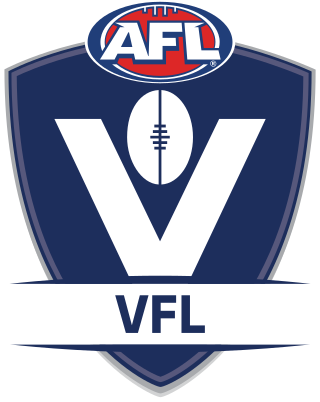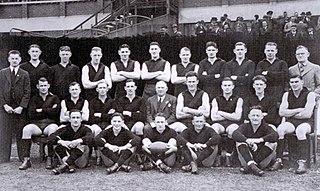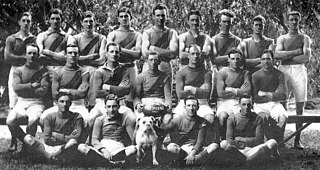
The Victorian Football League (VFL) is an Australian rules football competition in Australia operated by the Australian Football League (AFL) as a second-tier, regional, semi-professional competition. It includes teams from clubs based in eastern states of Australia: Victoria, New South Wales and Queensland, including reserves teams for the eastern state AFL clubs. It succeeded and continues the competition of the former Victorian Football Association (VFA) which began in 1877. The name of the competition was changed to the Victorian Football League in 1996. Under its VFL brand, the AFL also operates a women's football competition known as VFL Women's, which was established in 2016.

Alexander Eason was an Australian rules football player, coach and administrator in the Victorian Football League and Victorian Football Association.

The 1925 VFL season was the 29th season of the Victorian Football League (VFL), the highest-level senior Australian rules football competition in Victoria. The season featured twelve clubs and ran from 2 May to 10 October, comprising a 17-match home-and-away season followed by a four-week finals series featuring the top four clubs. Victorian Football Association (VFA) clubs Footscray, Hawthorn and North Melbourne featured for the first time in 1925.

The 1942 VFL season was the 46th season of the Victorian Football League (VFL), the highest level senior Australian rules football competition in Victoria.

The 1897 Victorian Football Association season was the 21st season of the Australian rules football competition. The premiership was won by the Port Melbourne Football Club, the first premiership in its history.

The 1899 VFA season was the 23rd season of the Victorian Football Association (VFA), an Australian rules football competition played in the state of Victoria.

Archibald Frederick Roberts was an Australian rules footballer who played for the Melbourne Football Club and Essendon Football Club in the Victorian Football League (VFL). Roberts also played with Victorian Football Association (VFA) club Prahran after his VFL career ended.

Laurence Augustine "Gus" Dobrigh was an Australian rules footballer who played with Collingwood in the Victorian Football League (VFL).
Henry Charles "Harry" Kerley was an Australian rules footballer who played for Collingwood and St Kilda in the Victorian Football League (VFL).
The AFL Australian Football League is the top professional Australian rules football league in the world. The league consists of eighteen teams: nine based in the city of Melbourne, one from regional Victoria, and eight based in other Australian states. The reason for this unbalanced geographic distribution lies in the history of the league, which was based solely within Victoria from the time it was established in 1897, until the time the league expanded through the addition of clubs from interstate to the existing teams starting in the 1980s; until this expansion, the league was known as the VFL (Victorian Football League).

The 1907 Victorian Football Association season was the 31st season of the Australian rules football competition. The premiership was won by the Williamstown Football Club, after it defeated West Melbourne in the final by eighteen points. It was the first premiership won by Williamstown, in its 24th season of senior competition.

The 1918 Victorian Football Association season was the 40th season of the Australian rules football competition. Played during the final year of hostilities in World War I, the 1918 season was the first to be played since 1915; but it was a short season, played with only six clubs, and with only ten rounds of matches before the finals.

The 1919 Victorian Football Association season was the 41st season of the Australian rules football competition. The season was the first to be played after hostilities ended in World War I, and saw a return to a full-length season featuring all ten clubs for the first time since 1914.

The 1920 Victorian Football Association season was the 42nd season of the Australian rules football competition. The premiership was won by the Footscray Football Club, after it defeated Brunswick by 3 points in the final on 9 October. It was the club's seventh VFA premiership, drawing it level with Geelong for the most premierships in VFA history, and it was the club's second consecutive premiership.

The 1921 Victorian Football Association season was the 43rd season of the Australian rules football competition.
The 1923 Victorian Football Association season was the 45th season of the Australian rules football competition. The premiership was won by the Footscray Football Club, after it defeated Port Melbourne by 14 points in the Grand Final on 1 October. It was the club's eighth VFA premiership, which meant that the club surpassed Geelong (L.) for the most premierships won in VFA history.
The 1924 Victorian Football Association season was the 46th season of the Australian rules football competition. The premiership was won by the Footscray Football Club, after it defeated Williamstown by 45 points in the final on 20 September. It was the club's ninth and last VFA premiership before it, along with North Melbourne and Hawthorn, joined the Victorian Football League the following year; this marked the end of a long period of dominance for Footscray, which had seen it win five minor premierships in a row and four major premierships in six years.
The 1925 Victorian Football Association season was the 47th season of the Australian rules football competition. The premiership was won by the Brunswick Football Club, after it defeated Port Melbourne by 16 points in the final on 31 August. It was the club's second VFA premiership.
The Victorian Junior Football Association (VJFA), sometimes known simply as the Victorian Junior Association (VJA), was an open age Australian rules football competition and administrative body. It was the first successful junior football competition in Melbourne, and was in existence from 1883 until 1932.













